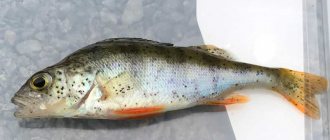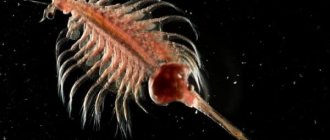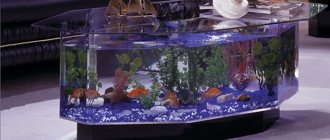Fish are a huge group of vertebrates that live in water. Their main feature is gill breathing. To move in a liquid environment, these animals use a wide variety of devices. The swim bladder is the most important hydrostatic organ that regulates diving depth, and is also involved in breathing and sound generation.
The swim bladder is the most important hydrostatic organ that regulates the diving depth of fish
Related species
The Australian goby is not alone; there are 10 more species in the psycholute family to which it belongs. These are all deep-sea fish that prefer to live in cold waters. This habit gave the family its name: from Greek “psychros” is translated as “cold”. Their common features are a poorly developed pelvic fin and a bare, scaleless body. Other representatives of the psycholute family are found in the Atlantic and Pacific oceans, both in the southern and northern parts, avoiding the equatorial and tropical zones. They live, depending on the species, at depths from 150 to 1000 m.
Hydrostatic function
The fish bladder is a multifunctional organ, but its main task is to stabilize the position in different conditions under water. This is a function of a hydrostatic nature, which, by the way, can be replaced by other parts of the body, which is confirmed by examples of fish that do not have such a bladder. One way or another, the main function helps fish stay at certain depths, where the weight of the water displaced by the body corresponds to the mass of the individual itself. In practice, the hydrostatic function can manifest itself as follows: at the moment of active immersion, the body contracts along with the bubble, and when ascent, on the contrary, it straightens out. During the diving process, the mass of the displaced volume is reduced and becomes less than the weight of the fish. Therefore, the fish can go down without much difficulty. The lower the dive, the higher the pressure becomes and the more the body is compressed. Reverse processes occur at the moment of ascent - the gas expands, as a result of which the mass is lighter and the fish rises upward with ease.
Character and lifestyle
Having practically no muscles, a drop of fish in the water can either not move at all, or drift with bottom currents. Her vision is adapted to her habitat: although the photometer records the sun's rays to a depth of 1,000 meters, the human eye can no longer distinguish light below 600 m; everything around us would seem equally black. And the drop fish manages to navigate in such conditions with the help of vision. In natural conditions, her eyes look completely different from those in terrestrial photographs. They protrude above the surface of the head and protrude slightly forward.
Functions of the senses
Along with its hydrostatic function, this organ also acts as a hearing aid in some way. With its help, fish can perceive noise and vibration waves. But not all species have this ability; carp and catfish are included in the category with this ability. But sound perception is provided not by the swim bladder itself, but by the whole group of organs to which it belongs. Special muscles, for example, can provoke vibrations of the walls of the bladder, which causes sensations of vibration. It is noteworthy that in some species that have such a bladder, hydrostatics are completely absent, but the ability to perceive sounds is preserved. This applies mainly to bottom-dwelling fish, which spend most of their lives at one level under water.
Interesting Facts
The drop fish was first caught almost 100 years ago, in 1926. She accidentally fell into the nets of Tasmanian fishermen. Then the unusual find was described, the species was given a name, and the study stopped there. Only at the end of the 20th century did psycholute again attract the attention of researchers: thanks to the development of technology, the study of deep-sea fish became somewhat easier.
The unusual appearance of the drop fish has repeatedly attracted the attention of film directors. It appears in The X-Files (episode "Rm9sbG93ZXJz", season 11, episode 7), where it is served to Mulder uncut in a robotic sushi bar. In the film “Men in Black 3,” the chef presented this creature as earthly, but no one believed him: the gelatinous creature with a sad, human-like face bears little resemblance to ordinary representatives of our fauna.
Internet users have repeatedly voted the Australian bull the ugliest animal on the planet. She even won over pubic lice, and since 2013 has been featured on the emblem of the Ugly Animals Conservation Society.
Human use[edit]
In some Asian cultures, the swim bladder of some large fish is considered a delicacy. In China they are known as " fish mouth"
, 花膠 / 鱼鳔, [22] and served in soups or stews.
The vanity cost of the endangered maw species is behind the imminent extinction of the vaquita, the world's smallest dolphin species. Found only in the California Gulf of Mexico, the once abundant vaquita is now critically endangered. [23] Vaquita dies in gill nets [24] set to catch totoaba (the world's largest drummer). Totoaba is hunted to extinction for its mouth, which can sell for $10,000 per kilogram.
Swim bladders are also used in the food industry as a source of collagen. They can be made into a strong, water-resistant glue or used to make glass to clarify beer. [25] They used to make condoms. [26]
Musculoskeletal system
In order for fish to be able to swim, they developed a radically new musculoskeletal system compared to the more ancient hagfishes and lampreys. Firstly, the fish developed fins. A pair of pectorals, abdominals. And one pelvic, dorsal and caudal fin. They are “attached” to muscles, the contractions of which cause the fins to change their position, generating movement. As a result of this, the animal can move in a horizontal, vertical plane, and turn around.
In addition to the fins, movement is supported by the work of the trunk muscles. Red muscle fibers are involved in the process of long, monotonous swimming. White muscle fibers “turn on” when a jerk, speed, or energetic but short movement is needed.
Other components that provide movement in the aquatic environment
In fact, the entire body of fish is adapted for movement and life in the thickness of water masses. For example, saturation of the body with oxygen using gills, features of the placement of sensory organs, functionality of the digestive and excretory systems.
Yes, and keep in mind, when discussing the ability of fish to swim, it should be taken into account that in the aquatic environment it was these animals that reached the maximum level of adaptation compared to more primitive forms. The next evolutionary step was the creation of organisms that “learned” to crawl, walk, and fly. One of the first “migrants” to land was the Order of Coelicant fishes, represented today by the relict coelacanth.
Swim bladder and lungs in different groups
Almost all bony fish have a swim bladder and usually function as a hydrostatic organ. Beginning as a very minor cellular extension from the intestines, the bladder in fish leads the entire group along an evolutionary channel.
What fish don't have a bladder?
It is absent in adult sharks, but a hint of a vestigial vesicle is observed during embryonic development. But almost all teleosts have it. As a result of adaptation to different ways of life, extreme modifications occur.
Gas filling of the bladder
Gas glands stabilize the pressure of the bladder. In particular, they help to increase it, and if it is necessary to decrease it, the red body, formed by a dense capillary network, is activated. Since pressure equalization in open-vesical fish occurs more slowly than in closed-vesical species, they can quickly rise from the water depths. When catching individuals of the second type, fishermen sometimes observe how the swim bladder protrudes from the mouth. This is due to the fact that the container inflates under conditions of rapid rise to the surface from depth. Such fish include, in particular, pike perch, perch and stickleback. Some predators that live at the very bottom have a greatly reduced bladder.
Character and lifestyle
Having practically no muscles, a drop of fish in the water can either not move at all, or drift with bottom currents. Her vision is adapted to her habitat: although the photometer records the sun's rays to a depth of 1,000 meters, the human eye can no longer distinguish light below 600 m; everything around us would seem equally black. And the drop fish manages to navigate in such conditions with the help of vision. In natural conditions, her eyes look completely different from those in terrestrial photographs. They protrude above the surface of the head and protrude slightly forward.
Description
During the embryonic development of fish, the swim bladder appears as a dorsal outgrowth of the intestinal tube and is located under the spine. With further development, the canal connecting the swim bladder to the esophagus may disappear. Depending on the presence or absence of such a channel, fish are divided into open- and closed-vesical. In open-vesical fishes ( physostome
) the swim bladder is connected throughout life to the intestines by an air duct through which gases enter and exit.
Such fish can swallow air and thus control the volume of the swim bladder. Open bladder fish include carp, herring, sturgeon and others. In adult closed-vesical fish ( physoclists
), the air duct becomes overgrown, and gases are released and absorbed through the red body - a dense plexus of blood capillaries on the inner wall of the swim bladder.
Read also: Feeding mash with sugar moonshine
Tags
swim bladder depth. Bubble for the function of the bubble swim bladder begins the swim bladder of adults the first bubble is filled fish bladder is the function of the swim bladder bubble. Filling the bladder fish swim bladder type of swim bladder using the swim bladder. Swim bladder plays swim bladder Swim bladder swim bladder disorders Pisces gas is taken in and gas is taken out and filled with gases expulsion of water on Pressure of water on
gasfunction airpressuregrowth than buoyancy locatedvolumelarger surfacesuch parts of the esophagusrespiration articledepthperforms gillscanaquatic is an organmainly someoccursone of the evolution of the vertebral canal of a certain ganoidsfor example structure oxygenair ventral weight fishcasvuka some respiratoryfirstinternal otherschange in the volume of which of the aquarium
Why don't fish drown?
Yuri Frolov, biologist
“Science and Life” No. 1, 2015
Everyone knows, at least from adventure and war films, how a submarine maneuvers at depth. It has special tanks where you can pump seawater or displace it with compressed air. More water means the boat gets heavier and sinks deeper; more air means it floats up.
Photo: © Victor Zastolsky / Lori Photobank
Many fish do much the same. Only their tank is elastic, changing its volume - this is the swim bladder, lying in the abdominal cavity. You've probably seen it if you've ever watched fresh fish being cleaned.
Picture: Sharon High School. commons.wikimedia.org.wiki
A typical fish is about 5% heavier than water. If she doesn't make an effort, she will sink to the bottom. The swim bladder equalizes the specific gravity of the fish with the specific gravity of the water, which allows the fish to hang motionless without floating or sinking. And in order to slightly change the depth, it is enough to slightly work with the fins. Of course, you need to adjust the depth on the go. Physiologists have determined that the swim bladder, maintaining buoyancy at low speeds, saves the fish up to 60% of effort, and with fast movement - more than 5%. By the way, when a person breathes shallowly, he has the same specific gravity as water, and after taking a deep breath, he becomes lighter than water. So it’s not so easy for us to drown.
In evolution, the swim bladder arose from the intestines. Part of the esophagus or stomach became isolated and began to serve not for nutrition, but for regulating the specific gravity of the fish. At this stage of evolution, for example, is the sand shark: it does not have a swim bladder, but part of the stomach is separated in the form of a pocket into which the shark swallows a little air so as not to drown.
The sandbar shark (family
Odontaspididae
) does not have a swim bladder. Its role is performed by a separate part of the stomach. Photo: Richard Ling / Wikimedia Commons / CC-BY-SA-2.0.
In some fish (for example, salmon, herring, carp), a narrow canal remains between the swim bladder and the esophagus. They can, having floated to the surface, swallow air into the bubble, which will allow them to remain in the upper layers of the reservoir. If you need to dive deeper, the fish can exhale a little.
Carp ( Cyprinus carpio carpio
) can swallow some air, floating to the surface, and it will enter the swim bladder from the esophagus through a narrow channel. Photo by Sergey Gorlanov
In other fish (cod, perch, hake), the bladder is completely closed and separated from the intestine. In order to inflate or deflate it slightly, you need a pump. These fish even have two pumps, and they are located in the bladder itself. A special gland, through a cunning biochemical mechanism, takes gases from the blood (and they get there through the gills from the water - after all, air gases are dissolved in water even at great depths) and removes them into the bladder. At the other end of the bladder there is an area riddled with blood vessels. Through them, gases are transferred back into the blood if necessary. Both processes are quite slow.
In sea perch (
Sebastes sp.
), as well as in river perch, the bladder is closed and completely separated from the intestine. Photo: jovibor
Why do fish need to change depth at all? First of all, in pursuit of food, for example plankton, which either floats up or sinks. Also, to hide from predators waiting at a certain depth. Some species emerge or submerge to spawn, and outside the breeding season live at a different depth.
Finally, many fish do not have a swim bladder at all. These are bottom-dwelling species, such as flounder, that swim quietly near the bottom and collect food from it. Cartilaginous fish such as sharks and rays do not have a swim bladder. Perhaps because their skeleton, consisting of cartilage, is lighter than the bony skeleton of other fish. Fast-swimming predatory fish, such as tuna and Atlantic mackerel, also do without a bladder (its throwing speed reaches 77 km/h). The powerful muscles of these predators allow them to quickly change depth and resist diving. But it is quite difficult to derive some general rule about who has a bubble and why and who does not. Of two closely related species with a similar way of life, one may not have a bladder, while the other may have a fully developed one.
Flounders, like many other bottom-dwelling fish, do without a swim bladder at all. In the photo: leopard flounder, or spotted bothus ( Bothus pantherinus
). Photo: © Sergey Dubrov / Photobank Lori
Fish have other ways to reduce their specific gravity so as not to sink. For example, accumulate fat, because it is lighter than water. Thus, in one species of shark, the liver consists of 75% fat (in mammals, the liver contains 5% fat). Another option is to use the active work of the kidneys to get rid of heavy salts in the blood and other fluids inside the body. It is not for nothing that shipwrecked sailors, if the supply of fresh water in the boat has run out, drink juice squeezed from sea fish: it is almost fresh.
But if a living organism has any organ, it must be used as widely as possible so that it does not sit idle in vain. Some fish make sounds with their bladder, others use it as a resonator to increase hearing sensitivity. The bladder can serve as a depth sensor: when ascending, its volume increases, when diving, it decreases, and the nerve endings sense this. Finally, the fish can use the air from the bladder as a reserve for breathing during a sprint jerk.
And here’s what’s interesting: from the swim bladder of fish, the lungs of terrestrial vertebrates, including humans, arose.
Risk of injury[edit]
Many human activities, such as pile driving or even seismic waves, can create high-intensity sound waves that cause some damage to fish that have a gas bubble. Physostomes can release air to relieve tension in the gas bladder, which can cause internal damage to other vital organs, while Physoclisti cannot expel air fast enough, making it difficult to prevent serious injury. [28] Some of the most common injuries included gas bladder rupture and renal hemorrhage. This mainly affects the overall health of the fish and does not affect their mortality. [28] The researchers used high-intensity controlled impedance-filled fluid (HICI-FT), a stainless steel wave tube with an electromagnetic shaker. It simulates high energy sound waves in a plane wave environment in the far field of water. [29] [30]
What does it eat?
The Australian goby is a predator, unlike most benthic inhabitants that feed on carrion. The main part of the diet of drop fish is small marine invertebrates drifting in the bottom areas. This fish is a passive hunter; it does not swim after prey, but stays in one place. Australian gobies eat the plankton that floats into their mouths.
An important problem with psychrolutes is that at depth there is not as much life, and therefore food, as in the upper layers of the ocean. The fish itself is not very well adapted to moving long distances for food, which means that if it is unlucky, it may be in danger of starvation.
Main Enemies
According to modern scientists, the Australian bull has no natural enemies. Theoretically, these could include deep-sea squid, angler fish and other predatory inhabitants of the seabed, but whether this is so, as well as what tactics the psychrolute uses to protect itself from predators, is not known for certain. But it is clear that the population of these inhabitants of the depths is rapidly declining. This is due to humans, or more precisely, to the bottom fishing of marine crustaceans - lobsters and crabs. Along with the delicacy, a strange, sedentary fish also ends up in the net. Thus, a person casually destroys a species that is edible only conditionally and has no other economic value: after trawling, there is no point in releasing fish into the sea that have received injuries incompatible with life due to a rapid change in pressure. Even if it is alive at the time of catching, death after such exposure is inevitable.











